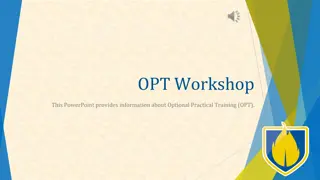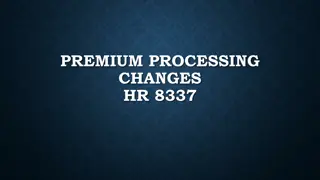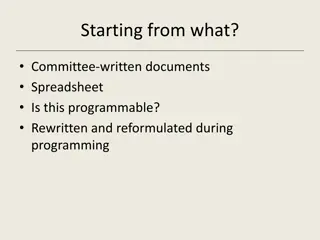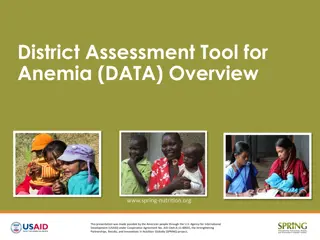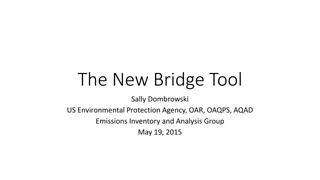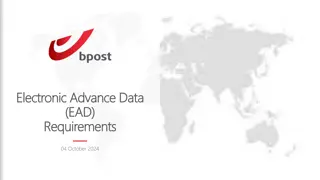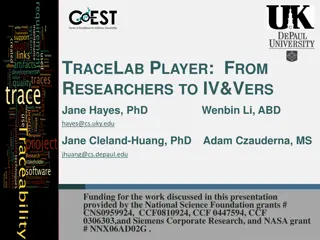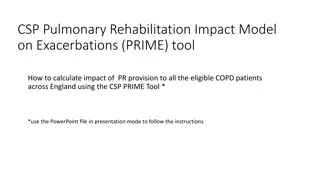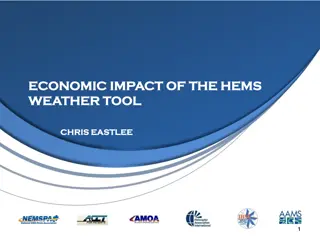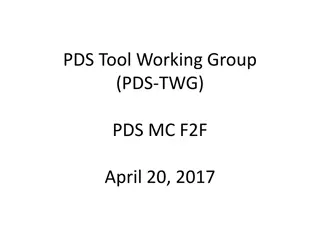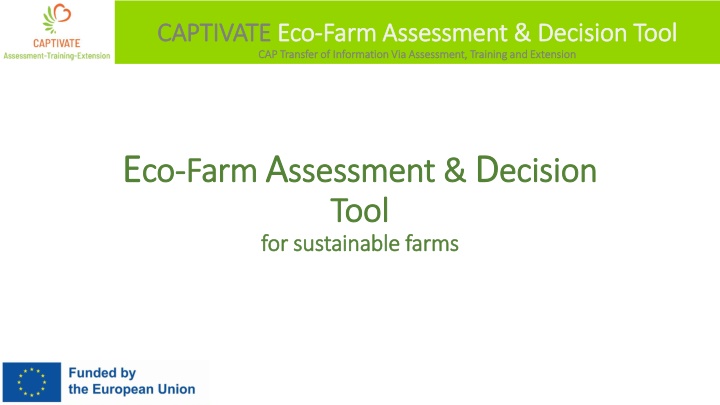
Sustainable Farm Assessment and Decision Tool Development
The CAPTIVATE Eco Farm Assessment & Decision Tool aims to increase on-farm ecological sustainability while considering socio-economic aspects. It goes beyond sustainability assessment by including benchmarking, capacity building, and decision support. The tool responds to different geographical settings in Hungary, Slovakia, and Croatia, encompassing various farm types and system boundaries. Developed through a multi-criteria analysis approach, users can conduct a self-assessment within two hours, utilizing indicators from the SAFA Guidelines and SMART Farm Tool.
Download Presentation

Please find below an Image/Link to download the presentation.
The content on the website is provided AS IS for your information and personal use only. It may not be sold, licensed, or shared on other websites without obtaining consent from the author. If you encounter any issues during the download, it is possible that the publisher has removed the file from their server.
You are allowed to download the files provided on this website for personal or commercial use, subject to the condition that they are used lawfully. All files are the property of their respective owners.
The content on the website is provided AS IS for your information and personal use only. It may not be sold, licensed, or shared on other websites without obtaining consent from the author.
E N D
Presentation Transcript
CAPTIVATE CAPTIVATE Eco Eco- -Farm Assessment & Decision Tool Farm Assessment & Decision Tool CAP Transfer of Information Via Assessment, Training and Extension CAP Transfer of Information Via Assessment, Training and Extension E Eco co- -Farm Farm A Assessment & ssessment & D Decision Tool Tool for sustainable farms for sustainable farms ecision
CAPTIVATE Eco CAP Transfer of Information Via Assessment, Training and Extension Eco- -Farm Assessment & Decision Tool Farm Assessment & Decision Tool Development process and final configuration 1. Main properties and delimiting parameters -> increase on-farm ecological sustainability -> also socio-economic aspects (supplementary risk assessment) to reflect complex system interactions -> beyond sustainability assessment: benchmarking, capacity building, knowledge management, decision support, and communication of results. -> respond to different geographical settings according to the project countries (Hungary, Slovakia, and Croatia).
CAPTIVATE Eco CAP Transfer of Information Via Assessment, Training and Extension Eco- -Farm Assessment & Decision Tool Farm Assessment & Decision Tool Development process and final configuration 2. System boundaries to describe the framework of the system under study -> 10 most important farm types (FADN) -> include entire farm, encompassing all branches of farming Mixed crops and livestock Specialist COP (Cereals, Oilseeds and Protein crops) Specialist milk Specialist sheep and goats Mixed crops Specialist other fieldcrops Mixed livestock Specialist cattle Specialist wine Specialist horticulture Specialist olives Specialist granivores Specialist orchards - fruits Permanent crops combined -> agricultural sector and primary production (excluding tourism, processing, etc.). -> area observed includes the agricultural area, husbandry, and effects on and through nearby areas
CAPTIVATE Eco CAP Transfer of Information Via Assessment, Training and Extension Eco- -Farm Assessment & Decision Tool Farm Assessment & Decision Tool Development process and final configuration 3. Structure of the tool based on alignment and the aimed properties -> Multi-Criteria Analysis -> Level of detail was determined by the need for user- friendliness and easy applicability -> Aim was that users are able to conduct a self- assessment within two hours of time
CAPTIVATE Eco CAP Transfer of Information Via Assessment, Training and Extension Eco- -Farm Assessment & Decision Tool Farm Assessment & Decision Tool Development process and final configuration 4. Selection and development of indicator set sources i.e. SAFA Guidelines and SMART Farm Tool (Sustainability Monitoring and Assessment Routine) -> mostly practice based indicators Number: Farm in general 14; Animal husbandry 42 (species); Plant production 40 (branches); Socio-Economic RA 24; Ecology RA 22; Weighting process: impact on each eco-subtheme Languages English, Hungarian, Croatian, Slovakian Assessments: 68
CAPTIVATE Eco CAP Transfer of Information Via Assessment, Training and Extension Eco- -Farm Assessment & Decision Tool Farm Assessment & Decision Tool Development process and final configuration KOBO Toolbox
CAPTIVATE Eco CAP Transfer of Information Via Assessment, Training and Extension Eco- -Farm Assessment & Decision Tool Farm Assessment & Decision Tool Development process and final configuration Results Main data of the farm Radar chart - showing the farm performance by eco-themes (SAFA sub-themes) in percentages, compared with the ideal farm (goal) Good results above 70%, weaker results ( needs to be improved ) under 40% List of subtheme goal achievement Recommended good eco-practices and CAP measures, based on the results under the SAFA sub- themes, according to farm branches, and linked CAP measures. List of indicators which are contributing the most to stronger and weaker results (making the more positive or negative impacts) Risk assessment section
CAPTIVATE Eco CAP Transfer of Information Via Assessment, Training and Extension Eco- -Farm Assessment & Decision Tool Farm Assessment & Decision Tool Development process and final configuration Results Main data of the farm Radar chart - showing the farm performance by eco-themes (SAFA sub-themes) in percentages, compared with the ideal farm (goal) Good results above 70%, weaker results ( needs to be improved ) under 40% List of subtheme goal achievement Recommended good eco-practices and CAP measures, based on the results under the SAFA sub- themes, according to farm branches, and linked CAP measures. List of indicators which are contributing the most to stronger and weaker results (making the more positive or negative impacts) Risk assessment section
CAPTIVATE Eco CAP Transfer of Information Via Assessment, Training and Extension Eco- -Farm Assessment & Decision Tool Farm Assessment & Decision Tool Development process and final configuration Results Main data of the farm Radar chart - showing the farm performance by eco-themes (SAFA sub-themes) in percentages, compared with the ideal farm (goal) Good results above 70%, weaker results ( needs to be improved ) under 40% List of subtheme goal achievement Recommended good eco-practices and CAP measures, based on the results under the SAFA sub- themes, according to farm branches, and linked CAP measures. List of indicators which are contributing the most to stronger and weaker results (making the more positive or negative impacts) Risk assessment section
CAPTIVATE Eco CAP Transfer of Information Via Assessment, Training and Extension Eco- -Farm Assessment & Decision Tool Farm Assessment & Decision Tool Development process and final configuration Results Main data of the farm Radar chart - showing the farm performance by eco-themes (SAFA sub-themes) in percentages, compared with the ideal farm (goal) Good results above 70%, weaker results ( needs to be improved ) under 40% List of subtheme goal achievement Recommended good eco-practices and CAP measures, based on the results under the SAFA sub- themes, according to farm branches, and linked CAP measures. List of indicators which are contributing the most to stronger and weaker results (making the more positive or negative impacts) Risk assessment section
CAPTIVATE Eco CAP Transfer of Information Via Assessment, Training and Extension Eco- -Farm Assessment & Decision Tool Farm Assessment & Decision Tool Development process and final configuration Results Main data of the farm Radar chart - showing the farm performance by eco-themes (SAFA sub-themes) in percentages, compared with the ideal farm (goal) Good results above 70%, weaker results ( needs to be improved ) under 40% List of subtheme goal achievement Recommended good eco-practices and CAP measures, based on the results under the SAFA sub-themes, according to farm branches, and linked CAP measures. List of indicators which are contributing the most to stronger and weaker results (making the more positive or negative impacts) Risk assessment section
CAPTIVATE Eco CAP Transfer of Information Via Assessment, Training and Extension Eco- -Farm Assessment & Decision Tool Farm Assessment & Decision Tool Development process and final configuration Results Main data of the farm Radar chart - showing the farm performance by eco-themes (SAFA sub-themes) in percentages, compared with the ideal farm (goal) Good results above 70%, weaker results ( needs to be improved ) under 40% List of subtheme goal achievement Recommended good eco-practices and CAP measures, based on the results under the SAFA sub- themes, according to farm branches, and linked CAP measures. List of indicators which are contributing the most to stronger and weaker results (making the more positive or negative impacts) Risk assessment section
CAPTIVATE Eco CAP Transfer of Information Via Assessment, Training and Extension Eco- -Farm Assessment & Decision Tool Farm Assessment & Decision Tool Development process and final configuration Results Main data of the farm Radar chart - showing the farm performance by eco-themes (SAFA sub-themes) in percentages, compared with the ideal farm (goal) Good results above 70%, weaker results ( needs to be improved ) under 40% List of subtheme goal achievement Recommended good eco-practices and CAP measures, based on the results under the SAFA sub- themes, according to farm branches, and linked CAP measures. List of indicators which are contributing the most to stronger and weaker results (making the more positive or negative impacts) Risk assessment section
CAPTIVATE Eco CAP Transfer of Information Via Assessment, Training and Extension Eco- -Farm Assessment & Decision Tool Farm Assessment & Decision Tool EAD Tool CAPTIVATE Knowledge platform Assessment Materials for capacity building: - e-Learning Platform - Glossary - Farmers Handbook - videos - etc.
CAPTIVATE Eco CAP Transfer of Information Via Assessment, Training and Extension Eco- -Farm Farm Assessment & Decision Tool Assessment & Decision Tool The Eco-Farm Assessment and Decision (EAD) Tool is adigital self assessment approach for farmers and advisors to evaluate ecological sustainability at farm level, comprising a set of sustainability indicators that attempt to provide information about the current status and that can assist during farmer s decision making process to identify suitable CAP Measures and Eco-practices.




